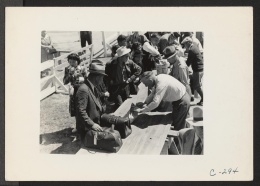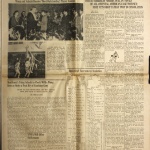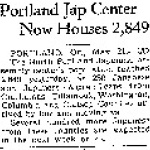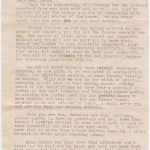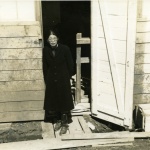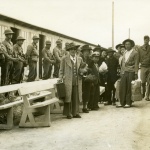Turlock (detention facility)
This page is an update of the original Densho Encyclopedia article authored by Kayla Canelo. See the shorter legacy version here .
| US Gov Name | Turlock Assembly Center, California |
|---|---|
| Facility Type | Temporary Assembly Center |
| Administrative Agency | Wartime Civil Control Administration |
| Location | Turlock, California (37.4833 lat, -120.8333 lng) |
| Date Opened | April 30, 1942 |
| Date Closed | August 12, 1942 |
| Population Description | Held people from East Bay Area, Solano County and Los Angeles, California. |
| General Description | Located in the town of Turlock, California. |
| Peak Population | 3,661 (1942-06-02) |
| Exit Destination | Gila River |
| National Park Service Info | |
The Turlock Assembly Center had the third smallest peak population among " assembly centers ," at 3,662 and was open for 105 days, from April 30 to August 12, 1942. Built on the site of the Stanislaus County Fairgrounds in Turlock, its inmate population was one of the most diverse of any "assembly center" and mostly consisted of people who had to travel a substantial distance to get there. The main population groups included contingents from Vacaville and other parts of Solano County, the San Francisco Bay Area (particularly the East Bay), Little Tokyo in Los Angeles, and Walnut Grove. The entire population eventually transferred to the Gila River , Arizona, War Relocation Authority concentration camp. Still the site of the fairgrounds, a small historical marker and two storyboards memorialize the site today.
Site History/Layout/Facilities
The Turlock Assembly Center was built on the site of the Stanislaus County Fairgrounds in Turlock, California, located about fifteen miles southwest of Modesto and eighty miles northwest of Fresno. The fairground was the site of an annual fair that began as the Turlock Melon Carnival in 1911. The camp was under construction when Camp Manager Ernest G. Pinnella arrived on April 7, 1942, and a letter from the army engineers reported that the camp was completed and turned over to the WCCA on April 15, about two weeks before the arrival of the first inmates. [1]
In his May 28 report for the Secretary of War, Pinnella wrote that the original capacity of the camp was to be 3,000, but that it was later increased to 4,000. Perhaps for this reason, there is some conflicting information in contemporaneous sources as to the number of barracks and other buildings that made up the camp. In the May 28 report, Pinnella wrote that the initial plan was for 131 barracks, each 20 x 100. But when the capacity was raised to 4,000, the camp administration determined that six "odd size buildings" in Block A could be used to bolster the housing stock. This account matches a June 16 "'As Built' Layout Plan" that shows 137 barracks. Though the legend for the plan cites each barrack as being 20 x 100, six of the barracks look notably larger and likely correspond to the "odd size buildings" mentioned by Pinnella. However, a list of inmate leadership in the June 26 issue of the TAC , the camp newspaper, mentions only 126 barracks. [2]
The size and shape of the "odd size buildings" generally correspond to the former stables that were converted into inmate housing at Tanforan and Tulare, so it is possible horse stalls were used in this fashion at Turlock as well. There is at least one former inmate account—that of Rev. Gibun Kimura of the Vacaville Buddhist Temple—that recalls being housed in "a former horse stable with partitions and asphalt for the floor." There are no contemporaneous documents that mention the use of former stables to house inmates, however, so the question as to what these six building were—and even if they were actually used as barracks—remains uncertain. [3]
There is no mention of blocks in either the May 28 report or the June 16 Layout Plan, but seven or eight blocks are noted in the camp newspaper and other contemporaneous documents, sometimes by letter and sometimes by number. Barracks are nonetheless numbered consecutively, from one to 137 (or 126). The June 16 layout plan lists eight mess halls (20 x 100)—which matches the eight blocks—along with sixteen showers (20 x 28), thirty-one latrines (8 x 20), and four laundries (20 x 100, with one double-sized at 40 x 100). The administration building, three hospital buildings, the store, and six warehouses were situated east of the inmate area and between the main entrance and inmate area. A parking area, garden, and baseball field were to the west of the inmate area. A grandstand with a capacity of 3,000 was located in the southern part of the inmate area and an outdoor pavilion with capacity of 500 was located east of the barracks; both were used for religious and recreational activities. The entire complex was surrounded by seven guard towers and, presumably, a barbed wire fence. Latrines seem to have been of the outhouse/pit toilet type, essentially just a hole in the ground with toilet seats over them. "It was dirty and it stunk," said Gilbert Kuramitsu in a 1943 interview. "We just had outhouses." Inmates at Turlock seem to have been issued cotton mattresses versus the canvas tics that had to be filled with straw as at many other "assembly centers." [4]
Reports note various problems tied to high winds and the summer heat. However, sanitation seems to have been the main recurring problem. The first issue of the camp newspaper calls sanitation "the foremost problem confronting our camp life," noting in particular the swarms of flies resulting from the outhouses and urging inmates to close toilet covers and make fly swatters out of "a piece of screen attached to a stick" in a "SWAT THE FLY" campaign. An inmate Department of Public Welfare and Sanitation noted various problems. In June, they made a "very urgent" request that steps be taken to alleviate "the over-flow of sewage in all laundries," that caused two of the laundries to be closed for three days. In July, they noted "that many of the toilets were rapidly being filled to capacity," and found "voluntary workers" in four of the blocks to dig new latrine pits to remedy the situation. Duckboard installed in the showers were also found to be "unsanitary," and the department suggested that inmates wear clogs while bathing subsequently. [5]
Camp Population
Turlock was one of the least populous assembly centers, with a peak population of 3,662. The inmate population came mostly from rural areas of California, including Vacaville and other parts of Solano County, the east San Francisco Bay Area, and Walnut Grove, along with about eight hundred from the Little Tokyo area in Los Angeles. The first group arrived on April 30, with large groups from Solano County and East Bay arriving on May 2 and 3, the Los Angeles group on May 17, and the Walnut Grove group of 479 on May 29. Relative to other assembly centers, none of these populations were particularly close to Turlock, necessitating long journeys by train. [6]
| Exclusion Order # | Deadline | Location | Number |
| 23 | May 3 | Solano County | 999 |
| 24 | May 3 | Contra Costa, Alameda, and San Joaquin Counties | 1,374 |
| 66 | May 17 | Los Angeles Lil' Tokio area | 835 |
| 94 | May 30 | Walnut Grove and Courtland | 473 |
Source: John L. Dewitt, Final Report: Japanese Evacuation from the West Coast, 1942 (Washington D.C.: U.S. Army, Western Defense Command), 363–66. Exclusion orders with fewer than thirty inductees not listed. Deadline dates come from the actual exclusion order posters, which can be found in The Japanese American Evacuation and Resettlement: A Digital Archive, Bancroft Library, UC Berkeley, http://digitalassets.lib.berkeley.edu/jarda/ucb/text/cubanc6714_b016b01_0001_1.pdf and http://digitalassets.lib.berkeley.edu/jarda/ucb/text/cubanc6714_b016b01_0001_2.pdf .
| Arrival Date | Number |
| April 30 | 98 |
| May 1 | 112 |
| May 2 | 1,152 |
| May 3 | 1,029 |
| May 10 | 1 |
| May 11 | 4 |
| May 14 | 3 |
| May 15 | 2 |
| May 17 | 781 |
| May 19 | 1 |
| May 23 | 2 |
| May 29 | 479 |
Source: Ernest G. Pinnella, Report of the Turlock Assembly Center for the Secretary of War, May 28, 1942, 1. General Correspondence Files, Turlock Center Manager, Reports of Physical Count thru Selective Service Registration, May 28 report by Pinnella, Reel 54, NARA San Bruno. The May 29 arrival date of the last group (from "Walnut Grove and vicinity") comes from the June 3 issue of the Turlock Flume , since this took place after Pinnella's May 28 report.
An anonymous crew member told a
Japanese American Evacuation and Resettlement Study
(JERS) researcher about the harrowing conditions inmates arriving at Turlock faced. A train carrying some six hundred inmates arrived at Turlock at about 2:30 pm, but had to sit "in the baking sun for two hours" until they could be inducted at 4:30, without toilets or water. At 4:30, they then had to walk a mile to the camp "carrying the babies and luggage they had brought." Rev. Gibun Kimura of the Vacaville Buddhist Temple tells a similar story in his 1976 memoir of arriving at Turlock. "It is still some two miles to the evacuation center so we are grouped in columns of three and marched by a military policeman....," he recalled. "The citizens of Turlock who live on either side of the street stare at us curiously as we walk by."
[7]
Essentially the entire population of the Turlock Assembly Center transferred to the Gila River, Arizona, concentration camp starting in mid-July, when the advance group of 520 left on July 18. Regular transfers began on July 25 with about 500 a day leaving for the next three days. Transfers were paused for about two weeks to allow Japanese Americans from the "white zone"—the area in the eastern half of California that had initially not been required to vacate—to enter Gila. The last three groups of 500 left from August 10 to 12. Turlock had been open for 105 days in total. There had been ten births and four deaths in the camp's life. [8]
| Departure Date | Number |
| July 18 | 520 |
| July 25 | 510 |
| July 26 | 513 |
| July 27 | 519 |
| August 10 | 507 |
| August 11 | 502 |
| August 12 | 502 |
Source: John L. Dewitt, Final Report: Japanese Evacuation from the West Coast, 1942 (Washington D.C.: U.S. Army, Western Defense Command), 282–84.
Another JERS fieldworker,
Robert Spencer
, described the Turlock population as particularly "Japanesey," based on his interactions with them after they had transferred to Gila. He wrote that nearly all of the Turlock inmates spoke Japanese, about 85% were Buddhist, and that more families had sent children to Japan to be educated, resulting in a relatively higher percentage of Kibei. "The lingua franca of the camp is Japanese definitely," he wrote. He also described the inevitable clashes with the Los Angeles group, who "are thought to be rowdyish and are most unpopular to all."
[9]
Staffing
The manager of Turlock for the life of the camp was Ernest G. Pinnella, a forty-two-year-old San Franciscan who had been a property custodian for the U.S. Department of Agriculture. As was the case at many of the "assembly centers," a number of managerial staff members came from the ranks of the WPA, including Scott Anderson, the supervisor of property and records, and Melvin E. Pearson, the supervisor of supplies and property, both of whom had come from the Utah WPA and Philip Lewis, chief of the personnel section, and Philip G. Dunn, head of works and maintenance, both of whom had come from the California WPA. [10]
The two staffers who worked most closely with the inmates were Lester M. Flewelling, the supervisor of the service division and Alfred J. Azevedo, the recreation director. Flewelling was from Reedley, California, and was a University of California graduate who had been transferred to Turlock from the WCCA main office in San Francisco. Azevedo, just thirty-years-old, was from Oakland where he had worked for the Oakland Recreation Department. A graduate of San Jose State College, he had three years of graduate school at the University of California. He left in mid-June to join the army. [11]
Other key staffers included
Mess and lodging supervisor: Joseph Kelley, succeeded by Claude A. White
Store manager: Roy Erickson
Fire chief: Ralph C. Carlson
Police chief: Wayne W. Want
[12]
For unknown reasons, the administration at Turlock did not issue clothing allowances to inmates and also did not issue final paychecks to inmate workers before the camp closed. Turlock inmates later found out that inmates at other assembly centers did receive clothing allowances and were fully paid for their work, and their subsequent dissatisfaction contributed to the unrest at Gila River. [13]
Institutions/Camp Life
Community Government
By the end of May, Center Manager Ernest G. Pinnella had appointed a four-member Center Council, each of whom was put in charge of a specific area:
Dr. George R. Baba, a twenty-nine-year-old Nisei doctor from San Francisco; the hospital chief, he was head of the sanitation and safety committee. Baba had practiced in San Francisco and San Mateo Counties before the war, but despite his expressed desire to be removed with members of that community, he was sent to Turlock (and later Gila River), where he was largely unfamiliar with his fellow inmates and they with him.
Joe Omachi, a thirty-two-year-old Nisei attorney from Stockton; head of the welfare commission. Born and raised in Loomis, he was a graduate of the University of California, Berkeley and the Hastings College of Law and the vice-president of the Stockton JACL .
Takeo Tada, a thirty-three-year-old Kibei from Los Angeles; head of the employment and personal services commission. A graduate of Fresno State College, he had been the secretary of the Japanese Chamber of Commerce in Los Angeles.
Tomoko Yamamoto, a fifty-seven-year-old Issei from San Francisco who was described as a "welfare worker"; head of the education and recreation commission and the only woman and only Issei of the group.
Each of the council members expressed avowedly pro-American and pro-administration views whether at Turlock or later at Gila River. [14]
The council appointed inmate block wardens, and each barrack had a barrack warden "selected by the family heads resident in each barracks," according to a report by Service Division Head Lester M. Flewelling. Block wardens were to meet weekly with barrack wardens. In his June 23 weekly narrative report, Camp Manager Pinnella notes plans for a July 1 election for a new Center Council, with the present council to continue to serve as an advisory board. But no further mention of the election appears, perhaps because of the imminent closing of the camp. [15]
As noted above, Turlock inmates failed to get the clothing allowances and some wages that inmates at many other assembly centers received, with council members defending the administration on these issues. Some council members bore the brunt of inmate anger over this after the transfer to Gila; the anger climaxed with the beating of Tada in November 1942. [16]
Education
Given the short life of the camp, there was little in the way of a formal education program at Turlock. Inmates put together a preschool program that included six classes with a total of ninety students by the end of May as well as "informal elementary school classes under the grandstand," according to the report for the secretary of war. There was also a "large room [that] has been reconditioned for girls from six to nine years of age," with "nearly one hundred girls... in a semi-school and quiet game program," according to a May 19 report. One hundred fifty adults had signed up for English classes by the end of May, there were also Red Cross sponsored first aid courses and sewing the knitting classes to make items for servicemen. As at many other assembly centers, a graduation ceremony was held (on June 14) for over a hundred students who were missing their elementary, high school or college graduations. [17]
Medical Facilities
Three hospital barracks were located in the southeast corner of the camp and run by inmate doctors and other staff. Dr. George R. Baba was the hospital chief; other doctors included Takenosuke Nakamura, Yoshitaka Nakano, and Tetsuo Sugiyama. There were also three registered nurses, four dentists, a pharmacist, and a bacteriologist, along with various other staff. At the time of the May 28 report to the secretary of war, two of the hospital barracks had been completed. One included the outpatient department along with the pharmacy, laboratory and office and two wards for men, one each for contagious and non-contagious patients. The second building had the hospital kitchen, a delivery room and two labor rooms, along with two wards for female patients. According to the May 28 report, "equipment and supplies have been meager and incomplete in many important instances," with doctors having to use their own supplies and equipment. "Center sanitation has presented some problems difficult for immediate solution due to inadequate equipment and supplies." [18]
Library
The camp library was established as a branch of the Turlock City Library by its librarian, Susie Love. Located in a separate building located between Barracks 134 and 135 at the south end of the camp, the main library opened in late May. Made up of books lent by the city library and donations by staff and inmates, the library was lending about 400 books a week according to the May 28 report to the secretary of war. Shizu Abe was the inmate librarian in charge. Later, in June, a second branch opened in Block D, Barrack 81, at the far northern end of the camp. [19]
Newspaper
The mimeographed camp newspaper began as the Turlock Flume , and its first four-page issue appeared on June 3, 1942. Subsequent weekly issues had the name TAC . A total of seven issues appeared, with the last issued dated July 17. Starting the with third issue, Akira Marutani topped the masthead as the editor, with Emi Mori as manager. Other contributors included Lillian Fukaye, Ruth Ishimine, and Motoi Nakamura, with Torie Yamaguchi doing the artwork.
Religion
Both Buddhist and Christian groups held weekly services that were well attended. Pinnella's May 28 report for the secretary of war estimates that about 24% of the population attended Sunday morning services, with Buddhist services averaging about 800 and Christian services about 450. Sunday schools drew another 200 children and were led by about twenty-five inmate teachers. Both the grandstand and outdoor pavilion were used for services. Inmate ministers led the services, with white Christian ministers from outside the camp also aiding with Christian services. There was also a Church Council made up of two Buddhist and two Christian elected representatives to coordinate religious activities. [20]
Recreation
Inmate recreation leaders headed by coordinators Charles Yonezo and Frances A. Onoda worked with staff supervisor Al Azevedo to cobble together a recreation program despite limited equipment and facilities. One locus of activity was the grandstand area, which was used for various types of entertainment including talent shows that drew up to 2,500 people. Two rooms adjacent to the grandstand were used for such indoor activities as table games and crafts. Athletic fields located west of the inmate area were another, with a main softball field being the site of Sunday doubleheaders that drew up to 2,000 spectators. Sumo tournaments drew up to 300 and judo classes eventually started in July. Move screenings began on June 20, though they were limited to short educational and sports shorts as well as travelogues and religious movies. As was the case at other assembly centers, there was little or no budget for supplies and equipment, so most were either "purchased by evacuees or donated by interested parties," according to the May 28 report. [21]
Store/Canteen
The camp store was located in the south part of the camp just west of the hospital barracks. It opened on June 1 and carried food items such as candy, ice cream, and soft drinks, along with dry goods, newspaper, cigarettes, and some clothing. Named the "Scriptorium," it was open from 10 am to 6 pm. According to Pinnella's June 16 weekly report, daily sales averaged $308. [22]
Visitors
No mention of a visitor policy was found. Due to the relatively long distance Turlock inmates had to travel from their prewar homes, it is likely that they received fewer visitors than inmates at other "assembly centers."
Chronology
April 30
The first group of ninety-eight inmates arrives at Turlock.
May 19
First camp baby, Yuriko, born in the Modesto General Hospital, to Mrs. Shigeaki Hayashino.
May 29
The last large group, 489 from the Walnut Grove area, arrive.
June 3
The first issue of the camp newspaper,
Turlock Flume
.
June 8
Grand opening of center store; 488 bars of ice cream were sold in the first hour.
June 14
Commencement exercises for graduates of elementary school to university take place. George Hedley of Mills College gave the keynote address to the 110 graduates.
July 17
Final issue of
TAC
.
July 18
First group leaves for Gila River.
August 12
The last group leaves for Gila, and the camp closes.
Quotes
"Our survey had indicated that many of the toilets were rapidly being filled to capacity, and upon our recommendation the latrine pits in Blocks A, B, D, and G have been dug by the voluntary workers in the respective blocks to remedy this situation."
Department of Public Welfare and Sanitation Report, July 4, 1942
[23]
"One thing that got me was the lavatory. It was dirty and it stunk. We just had outhouses. We never had no showers because there was no hot water. We just can't get it because so many people used it. Most people used to take their shower in the daytime."
Gilbert Kuramitsu, 1943
[24]
"Apparently the Turlock Assembly Center had not been as well managed as some of the others and there was considerable confusion and injustice in connection with the issuance of clothing and clothing allowances."
James Terry [Gila River project attorney], 1945
[25]
"The [medical] equipment and supplies have been meager and incomplete in many important instances. Examples: knife blades without handles; examining tables, without pads; needle holders, without needles, etc."
Ernest G. Pinnella, 1942
[26]
Aftermath
After the departure of the inmates, the site became the U.S. Army Turlock Rehabilitation Center. After the war, the fair returned and became the Stanislaus County Fair in 1956. The fair continues under that name to this day. The centennial fair in 2011 drew 245,000 people. [27]
Along with other California assembly centers, the Turlock site became California Historic Landmark #934 in 1980. At the behest of students from California State University, Stanislaus, and the Cortez chapter of the JACL, a monument and plaque was installed at the north gate of the fairgrounds in 2010. Storyboards that describe the history of the camp and of the forced removal and incarceration were added a year later. [28]
Notable Alumni
Reiko Sato
, actor
Paul Terasaki
, scientist, entrepreneur, and philanthropist
Michi Nishiura Weglyn
, writer and activist
For More Information
Burton, Jeffery F., Mary M. Farrell, Florence B. Lord, and Richard W. Lord. Confinement and Ethnicity: An Overview of World War II Japanese American Relocation Sites . Western Archeological and Conservation Center, National Park Service, 1999, 2000. Foreword by Tetsuden Kashima. Seattle: University of Washington Press, 2002.
Santos, Robert L. The Army Needs Men: An Account of the U.S. Army Rehabilitation Rehabilitation Center at Turlock, California, 1942-1945 . Denair, Calif.: Alley-Cass Publications, 1997.
Turlock Assembly Center video. Japanese American Memorial Pilgrimages, 2018.
Footnotes
- ↑ This article relies heavily on material from the National Archives branch in San Bruno, California, which has records of the Turlock Assembly Center as part of its collection of records from the Wartime Civil Control Administration, which ran the so-called "assembly centers." All material from San Bruno comes from the "Turlock Center Manager" files under "General Correspondence Files." Records will be cited by the section (which likely corresponds to the physical folder of the records) within the "Turlock Center Manager" section and by the reel number followed by "NARA San Bruno." Jeffrey F. Burton, et al., Confinement and Ethnicity: An Overview of World War II Japanese American Relocation Site (Seattle: University of Washington Press, 2002), 377–78; "Fair History," Stanislaus County Fair website, http://stancofair.com/fair-history/ ; Ernest G. Pinnella, Report of the Turlock Assembly Center for the Secretary of War, May 28, 1942, p. 1, Reports of Physical Count thru Selective Service Registration, May 28 report by Pinnella, Reel 54, NARA San Bruno; Letter, Clay Anderson to WCCA, Apr. 28, 1942, Medical Reports May 2 thru August 6, Reel 54, NARA San Bruno.
- ↑ Pinnella, Report of the Turlock Assembly Center for the Secretary of War, May 28, 1942, 2; "'As Built' Layout Plan, Alien Induction Point, Turlock Fairgrounds, Turlock California," June 16, 1942, Layout Plan of Center, Reel 53, NARA San Bruno; TAC , June 26, 1942, 7–8.
- ↑ Layout Plan, June 16, 1942; Gibun Kimura, Why Pursue the Buddha? (Los Angeles: The Nembutsu Press, 1976), cited in Duncan Ryūken Williams, American Sutra: A Story of Faith and Freedom in the Second World War (Cambridge, Mass.: The Belknap Press of Harvard University Press, 2019), 99–100.
- ↑ Layout Plan, June 16, 1942; "Religious Activities," Pinnella, Report of the Turlock Assembly Center for the Secretary of War, May 28, 1942, 2; Turlock Flume , June 3, 1–2; Gilbert Kuramitsu, interview by Tamotsu Shibutani, Nov. 1943, p 17, The Japanese American Evacuation and Resettlement: A Digital Archive, Bancroft Library, UC Berkeley BANC MSS 67/14 c, folder T1.9936, http://digitalassets.lib.berkeley.edu/jarda/ucb/text/cubanc6714_b284t01_9936.pdf ; Ernest G. Pinnella, Semi-weekly narrative report, Apr. 25, 1942, Medical Reports May 2 thru August 6, Reel 54, NARA San Bruno.
- ↑ Ernest G. Pinnella, Semi-weekly narrative reports, Apr. 25 and June 23, 1942, Medical Reports May 2 thru August 6, Reel 54, NARA San Bruno; Turlock Flume , June 3, 1–2; Memos, Department of Public Welfare and Sanitation to L. M. Flewelling, June 15, 20, and 27, and July 4, 1942, Health-Safety (Sanitation), Reel 53, NARA San Bruno.
- ↑ John L. Dewitt, Final Report: Japanese Evacuation from the West Coast, 1942 (Washington D.C.: U.S. Army, Western Defense Command), 227, 363–66; Pinnella, Report of the Turlock Assembly Center for the Secretary of War, May 28, 1942, 2; Turlock Flume , June 3, 4.
- ↑ [Virginia Galbraith], "Story of the Turlock Evacuation," The Japanese American Evacuation and Resettlement: A Digital Archive, Bancroft Library, UC Berkeley, BANC MSS 67/14 c, folder B8.03, http://oac.cdlib.org/ark:/28722/bk0013c5g3x/ ; Kimura, Why Pursue the Buddha? in Williams, American Sutra , 99–100.
- ↑ Dewitt, Final Report , 202, 282–84; Letter, Elmer Rowalt to Dillon Myer, Oct. 2, 1942, The Japanese American Evacuation and Resettlement: A Digital Archive, Bancroft Library, UC Berkeley BANC MSS 67/14 c, folder B11.01 (1/2), http://digitalassets.lib.berkeley.edu/jarda/ucb/text/cubanc6714_b023b11_0001_1.pdf .
- ↑ Robert Spencer, Gila River Field Report #1, Aug. 23, 1942, The Japanese American Evacuation and Resettlement: A Digital Archive, Bancroft Library, UC Berkeley, BANC MSS 67/14 c, folder K8.38, http://digitalassets.lib.berkeley.edu/jarda/ucb/text/cubanc6714_b165k08_0038.pdf ; Robert F. Spencer, Diary report of visit to Gila, Aug. 15, 1942, The Japanese American Evacuation and Resettlement: A Digital Archive, Bancroft Library, UC Berkeley, BANC MSS 67/14 c, folder K8.35, http://digitalassets.lib.berkeley.edu/jarda/ucb/text/cubanc6714_b165k08_0035.pdf .
- ↑ TAC , June 19, 2; Pinnella, Report of the Turlock Assembly Center for the Secretary of War, May 28, 1942, 1.
- ↑ Pinnella, Report of the Turlock Assembly Center for the Secretary of War, May 28, 1942, 1; TAC , June 26, 2 and July 3, 2.
- ↑ TAC , June 26, 8 and July 10, 1; Ernest G. Pinnella, Semi-weekly narrative report, May 9, 1942, Medical Reports May 2 thru August 6, Reel 54, NARA San Bruno.
- ↑ James Terry, "Narrative Report of Project Attorney [Gila River]," p. 13, Japanese American Evacuation and Resettlement Records, Bancroft Library at the University of California at Berkeley, BANC MSS 67/14 c, folder K7.50:2, https://oac.cdlib.org/ark:/13030/k6j10981/?brand=oac4 ; Tamie Tsuchiyama [and Richard Nishimoto], Administration Notes on Gila, Sept. 1943, pp. 14–15, The Japanese American Evacuation and Resettlement: A Digital Archive, Bancroft Library, UC Berkeley, BANC MSS 67/14 c, folder K8.66, https://oac.cdlib.org/ark:/28722/bk0013c959h/?brand=oac4
- ↑ General information on the council members from Gila River Final Authority Record, 12, 203, 247, and 303; Ernest G. Pinnella, Weekly narrative report, June 23, 1942, Medical Reports May 2 thru August 6, Reel 54, NARA San Bruno; TAC , June 26, 1942, 7; Minutes, Advisory Board, May 27, 1942, Instructions, Daily Teletype Reports, Etc. thru Japanese Council, Reel 53, NARA San Bruno. On Baba: Robert Henry Billigmeier, Manuscript on Tule Lake Hospital, May 7, 1943, The Japanese American Evacuation and Resettlement: A Digital Archive, Bancroft Library, UC Berkeley, BANC MSS 67/14 c, folder R 20.05, http://digitalassets.lib.berkeley.edu/jarda/ucb/text/cubanc6714_b257r20_0005.pdf ; on Omachi: TAC, July 10, 1942, 3 and Hope Omachi Kawashima Interview by Kristen Luetkemeier, Segment 4, Fresno, California, Sept. 10, 2014, Manzanar National Historic Site Collection, Densho Digital Repository; https://ddr.densho.org/media/ddr-manz-1/ddr-manz-1-154-transcript-180aa16dfc.htm ; on Tada: TAC , July 17, 1942, 2 and Arthur A. Hansen, "Taking It to the Limit: Cultural Politics and Community Control in the Gila River Relocation Center 1942–1943," in Barbed Voices: Oral History, Resistance, and the World War II Japanese American Social Disaster by Arthur A. Hansen (Louisville: University Press of Colorado), 150.
- ↑ Lester M. Flewelling, "Center Council Participation in Self Government and Center Operation, Turlock Assembly Center," undated, Instructions, Daily Teletype Reports, Etc. thru Japanese Council, Reel 53, NARA San Bruno; Ernest G. Pinnella, Weekly narrative report, June 23, 1942, Medical Reports May 2 thru August 6, Reel 54, NARA San Bruno.
- ↑ Terry, "Narrative Report of Project Attorney [Gila River], 13; Tsuchiyama [and Nishimoto], Administration Notes on Gila, Sept. 1943, 14–15. See the Gila River articles for more on the Tada beating.
- ↑ Pinnella, Report of the Turlock Assembly Center for the Secretary of War, May 28, 1942, 2, 5; Ernest G. Pinnella, Weekly narrative reports, May 19, June 2, and June 16, 1942, Medical Reports May 2 thru August 6, Reel 54, NARA San Bruno.
- ↑ "Hospital and Health," Pinnella, Report of the Turlock Assembly Center for the Secretary of War, May 28, 1942, 1–2; Hospital Staff list, Instructions General March 20 thru August L (sic), Reel 53, NARA San Bruno.
- ↑ Turlock Flume , June 3, 3; "Education and Recreation," Pinnella, Report of the Turlock Assembly Center for the Secretary of War, May 28, 1942, 5; Layout Plan, June 16, 1942; Service Division Personnel, June 18, 1942, Service Division, Reel 54, NARA San Bruno; Shizu Abe, Program Report, Library, July 14, 1942, Service Division, Reel 54, NARA San Bruno.
- ↑ "Religious Activities," Pinnella, Report of the Turlock Assembly Center for the Secretary of War, May 28, 1942, 2; Ernest G. Pinnella, Semi-weekly narrative report, May 19, 1942, Medical Reports May 2 thru August 6, Reel 54, NARA San Bruno.
- ↑ "Education and Recreation," Pinnella, Report of the Turlock Assembly Center for the Secretary of War, May 28, 1942; Lester M. Flewelling, "Turlock WCCA Assembly Camp Recreation Program," May 8, 1942, Service Division, Reel 54, NARA San Bruno; Service Division Personnel, June 18, 1942, Service Division, Service Division personnel, June 18, Reel 54, NARA San Bruno; Ernest G. Pinnella, Weekly narrative reports, June 23 and July 8, 14, and 21, 1942, Turlock Center Manager, Medical Reports May 2 thru August 6, Reel 54, NARA San Bruno.
- ↑ "Center Store," Pinnella, Report of the Turlock Assembly Center for the Secretary of War, May 28, 1942; Ernest G. Pinnella, Weekly narrative reports, June 2 and 16, 1942, Medical Reports May 2 thru August 6, Reel 54, NARA San Bruno; TAC , June 12, 1 and June 26, 3.
- ↑ Department of Public Welfare and Sanitation, Report for week ending July 4, 1942, Health-Safety (Sanitation), Reel 53, NARA San Bruno
- ↑ Gilbert Kuramitsu interview, 17.
- ↑ James Terry, "Narrative Report of [Gila River] Project Attorney," Japanese American Evacuation and Resettlement Records, Bancroft Library at the University of California at Berkeley BANC MSS 67/14 c, folder K7.50:2, https://oac.cdlib.org/ark:/13030/k6j10981/?brand=oac4 .
- ↑ "Hospital and Health," Pinnella, Report of the Turlock Assembly Center for the Secretary of War, May 28, 1942, p. 1.
- ↑ Barbara Wyatt, ed., Japanese Americans in World War II: National Historic Landmarks Theme Study (Washington, D.C.: National Historic Landmarks Program, National Park Service, U.S. Department of the Interior, 2012), 125; "Fair History," Stanislaus County Fair website, http://stancofair.com/fair-history/ .
- ↑ Wyatt, ed., Japanese Americans in World War II , 125; Kayla Canelo, "Turlock (detention facility)," Densho Encyclopedia, https://encyclopedia.densho.org/Turlock_(detention_facility)/ .
Last updated Dec. 30, 2020, 8:49 p.m..

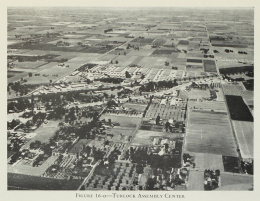 Media
Media

